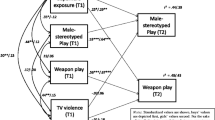Abstract
Barry, Bacon, and Child's (1957) cross-cultural study of sex differences in childhood socialization has been influential in bolstering the instrumental—expressive sex-role dichotomy. We critique their method of data analysis and factor analyze their data. Expressive and instrumental socialization are found to be separate factors or dimensions, rather than opposite ends of a single dichotomy. Additionally, no factor representing sex differences in socialization emerges, but rather each factor tends to contain substantively similar emphases in the training of both boys and girls.
Similar content being viewed by others
References
Aronoff, J., & Crano, W. D. A re-examination of the cross-cultural principles of task segregation and sex role differentiation in the family. American Sociological Review, 1975, 40, 12–20.
Barry, H., III, Bacon, M. K., & Child, I. L. A cross-cultural survey of some sex differences in socialization. Journal of Abnormal and Social Psychology, 1957, 55, 327–332.
Barry, H., III, Bacon, M. K., & Child, I. L. Definitions, ratings and bibliographic sources for child training practices of 110 cultures. In C. S. Ford (Ed.), Cross-cultural approaches. New Haven: Yale University, 1967.
Bem, S. L. The measurement of psychological androgyny. Journal of Consulting and Clinical Psychology, 1974, 42, 155–162.
Bem, S. L. On the utility of alternate procedures for assessing psychological androgyny. Journal of Consulting and Clinical Psychology, 1977, 45, 196–205.
Christensen, H. T. Relationship between differentiation and equality in the sex role structure. In L. Lenero-Otero (Ed.), Beyond the nuclear family model. Beverly Hills: Sage, 1977.
Collins, R. Conflict sociology. New York: Academic Press, 1975.
Freeman, D. Margaret Mead and Samoa. Cambridge, MA: Harvard University Press, 1983.
Glennon, L. M. Women and dualism. New York: Longman, 1979.
Hendrix, L. Economy and child training reexamined. Ethos, 1985, 13, 246–261.
Johnson, G. D., & Hendrix, L. A cross cultural testing of Collins's theory of sexual stratification. Journal of Marriage and the Family, 1982, 44, 675–684.
Kelly, J. A., & Worell, J. New formulations of sex roles and androgyny: A critical review. Journal of Consulting and Clinical Psychology, 1977, 45, 1101–1115.
Levinger, G. Task and social behavior in marriage. In N. W. Bell & E. F. Vogel (Eds.), A modern introduction to the family. New York: Free Press, 1968.
Mead, M. Sex and temperament in three primitive societies. New York: William Morrow, 1935.
Minturn, L., & Guthrie, P. Ethnographer oversight in reporting of sex differences in aggression training. Behavior Science Research, 1978, 13, 287–294.
Murdock, G. P. Ethnographic atlas. Pittsburgh: University of Pittsburgh Press, 1967.
Parson, T. The social system. New York: Free Press, 1951.
Parsons, T., & Bales, R. F. Family, socialization, and interaction process. New York: Free Press, 1955.
Ramanaiah, N. V., & Martin, H. J. Convergent and discriminant validity of selected masculinity and femininity scales. Sex Roles, 1984, 10, 493–511.
Ray, A. A. SAS User's Guide. Cary NC: SAS Institute, 1982.
Tavris, C., & Offir, C. The longest war. New York: Harcourt, Brace, and Jovanovich, 1984.
Weitz, S. Sex roles. New York: Oxford University Press, 1977.
Whyte, M. K. Family role differentiation and women's subsistence contribution. American Sociological Review, 1976, 41, 376–379.
Whyte, M. K. Cross-cultural studies of women and the male bias problem. Behavioral Science Research, 1978, 13, 65–80.
Zelditch, M. Role differentiation in the nuclear family. In T. Parsons & R. F. Bales. Family, socialization and interaction process. New York: Free Press, 1955.
Author information
Authors and Affiliations
Rights and permissions
About this article
Cite this article
Hendrix, L., Johnson, G.D. Instrumental and expressive socialization: A false dichotomy. Sex Roles 13, 581–595 (1985). https://doi.org/10.1007/BF00287296
Issue Date:
DOI: https://doi.org/10.1007/BF00287296




